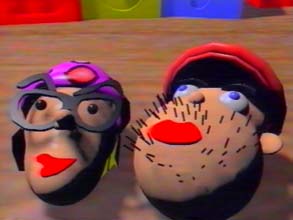Coldcut produced the first sample record in Great Britain in 1987 and are generally considered to be the founders of today's remix culture. Their experiments married music making and multimedia resulting in the development of software tools that promote new modes of creativity and aesthetic control for the VJ and DJ. In their live performances, they use their own software 'VJamm' and 'DJamm' (Matt Black is also a computer programmer). Besides their musical activities, they make interactive image and sound installations for museums and galleries, produce CD-ROMs, make radio, remix television and program their own record label's website. It is all part of their do-it-yourself philosophy.
After producing several hits and then having frustrating experiences with the music industry, Matt Black and Jonathon More decided to change tactics. Coldcut prefer to operate from the fringes rather than wrestle with the creative limitations imposed by the record industry. "Change always comes from the fringes," said Matt Black in an interview. They gathered a group of rebellious musicians and DJs around them and began their own record label. Inspired by the Ninja philosophy, they chose 'Ninja Tune' as the name for their activities. As well as a breeding ground for new talent, Ninja Tune is one of the most influential labels for alternative electronic dance music. The idea of starting their own record label arose from the need to be able to operate independently from the record industry. The word 'ninja' comes from the Japanese 'ninjutsu' which basically means 'the art of stealth' – Stealth was the name of the popular London club night organized by Coldcut/Ninja Tune. Ninjas combined in-depth knowledge of nature with the use of superior technology that gave them a reputation for being invincible. These warriors were known for their surprise attacks and bred confusion amongst their opponents with their sublime disappearing tricks. They appeared from nowhere, fought the enemy with their guerilla tactics and then dissolved back into the underground darkness.
Coldcut's political engagement was particularly noticeable on the album 'Let us Play'. The audio-visual track 'Timber' is a rhythmic montage of video material derived from a Greenpeace campaign against industrial logging of temporal rainforests in Canada. Coldcut worked together with video makers and remixers like Clifford Gilberto, Protean Vision Quest, Emergency Broadcast Network (one of the founders of video cut-ups) and Lucky People Centre, who made video remixes of 'Timber'. At the beginning of the nineties, Coldcut made several experimental interactive installations using the pseudonym 'Hex'. The resulting program 'Playtime' is an algorithmic music generator for automatic composition of techno/triphop and jungle tracks. 'My Little Funkit' is a do-it-yourself DJ game with which the user can make his or her own Coldcut track using the accompanying Coldcut samples.
Dissatisfied with the limitations of 'traditional' live video mixing, Coldcut developed the computer program VJamm in collaboration with Camart. VJamm ("I am therefore I jam") is the first sample instrument where audio and video fragments can be 'scratched' in real time using built-in functions like acceleration, slowing down, backwards playback and looping. Coldcut call VJamm 'a piano for sound and vision'. The average configuration of 'traditional' VJ equipment consists of three VCRs connected to a mixing panel. Whilst the videotapes are running, the VJ can mix and edit the three video feeds. VJamm gives the VJ a much greater degree of control over the material he or she is working with, partly because not three, but 16 audio-visual files can be used. The separate parameters of each clip can be set beforehand. The video images are loaded into the computer and played back using a PC keyboard or a midi-keyboard. During live performances, it enables Coldcut to respond directly to the audience's reaction to the images. For club VJs, VJamm's specific qualities could result in a more active collaboration or even a fusion between VJs and DJs usually operating independently. The principle behind the marketing of VJamm is the desire to promote live VJ-ing and digital audiovisual collage as a new form of expression. In the documentation with the computer program, Coldcut formulates a future vision for the 21st century in which they foresee video sampling becoming just as influential as audio sampling. With the motto "Don't hate the media, become the media", they propagate audio-visual collage as a means to win power over television. A primitive and hardly creative form of remixing television is known as 'channel-hopping'. In this sense, VJamm is a logical step forwards in the evolution of the remote control. A new version of the program is noe being developed.
As well as live performances and the showing of Hexstatic videoclips, there is a Ninja Tune design exhibition in the Melkweg gallery. Kevin Foakes (better know as Strictly Kev - one half of DJ Food) has been the main Ninja art director since 1993 when he restyled the company's logo and persuaded them to let him handle everything from then on. Seven years on he has completed designs for more than 100 different releases on Ninja Tune and its sister label Ntone as well as T-shirts, bags, posters, flyers and a varied range of related merchandise. The Xhibition features elements and details of favourite designs from the back catalogue specially selected for the World Wide Video Festival.
– Remco Vlaanderen |
DJs, VJs, musicians: Coldcut live, DJ Food (Strictly Kev), Amon Tobin, Jason Swinscoe (The Cinematic Orchestra), Kis Koala + P-Love, Roots Manuva & MK, Ollie Teeba (The Herbaliser), Mixmaster Morris, Dynamic Syncopation
Jonathon More, 1957, Thame (GBR)
Matt Black, 1961, Londen (GBR)
Living and working in Londen (GBR)
|
|

